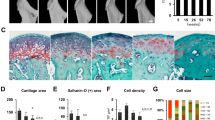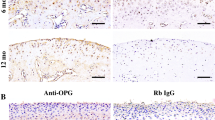Abstract
Matrix components of growth plate cartilage and mandibular condylar cartilage were immunohistochemically analyzed in cartilage calcification insufficient (CCI) rats, a model for dwarf rats. Reduction in total tibial length, elongation of growth plate, and appearance of noncartilaginous regions in the growth plate were observed in CCI rats. Immunoreactivity for type I collagen and hyaluronic acid (HA) staining were observed in the noncartilaginous region. However, weak immunoreactivity was observed for aggrecan, collagen types II and X, and decorin in this region. Transmission electron microscopy indicated that the noncartilaginous region showed a loose network of thin collagen fibrils, indicating that HA is predominantly involved in capturing space of the noncartilaginous region in the growth plate. Meanwhile, the mandibular condylar cartilage in CCI rats also showed elongation of the cartilaginous region and had a noncartilaginous region, predominantly comprising thick collagen fibrils. The structural difference between the two types of cartilages in CCI rats may be due to the presence of the fibrous cell zone and the fibrocartilaginous nature of the normal condylar cartilage. Additionally, the reduction in mandibular length was relatively less than the reduction in tibial length. The outline of the condylar process showed only slight abnormality. These results suggest that the condylar cartilage compensated its growth by supplying the characteristic noncartilaginous region effectively and may adapt to severe structural changes observed in CCI rats.






Similar content being viewed by others
References
Asari A, Miyauchi S, Miyazaki K, Hamai A, Horie K, Takahashi T, Sekiguchi T, Kohno K, Uchiyama Y (1992) Intra- and extracellular localization of hyaluronic acid and proteoglycan constituents (chondroitin sulfate, keratan sulfate, and protein core) in articular cartilage of rabbit tibia. J Histochem Cytochem 40:1693–1704
Ashida T (1996) Immunohistochemical studies of types I, II and X collagen in the mandibular cartilage of growing rats. Jpn J Oral Biol 38:80–88
Beresford WA (1981) Chondroid bone, secondary cartilage and metaplasia. Urban & Schwarzenberg, Baltimore, pp 23–47
Bianco P, Fisher LW, Young MF, Termine JD, Robey PG (1990) Expression and localization of the two small proteoglycans biglycan and decorin in developing human skeletal and non-skeletal tissues. J Histochem Cytochem 38:1549–1563
Chusho H, Tamura N, Ogawa Y, Yasoda A, Suda M, Miyazawa T, Nakamura K, Nakao K, Kurihara T, Komatsu Y, Itoh H, Tanaka K, SaitoY Katsuki M, Nakao K (2001) Dwarfism and early death in mice lacking C-type natriuretic peptide. Proc Natl Acad Sci USA 98:4016–4021
Davoli MA, Lamplugh L, Beauchemin A, Chan K, Mordier S, Mort JS, Murphy G, Docherty AJP, Leblond CP, Lee ER (2001) Enzymes active in the areas undergoing cartilage resorption during the development of the secondary ossification center in the tibiae of rats aged 0–21 days: II. Two proteinases, gelatinase B and collagenase-3, are implicated in the lysis of collagen fibrils. Dev Dyn 222:71–88
Del Santo M Jr., Marches F, Ng M, Hinton RJ (2000) Age-associated changes in decorin in rat mandibular condylar cartilage. Arch Oral Biol 45:485–493
Delatte M, Von den Hoff JW, Van Rheden REM, Kuijpers-Jagtman AM (2004) Primary and secondary cartilages of the neonatal rat: femoral head and the mandibular condyle. Eur J Oral Sci 112:156–162
Drury RAB, Wallington EA (1980) Carleton’s histological technique, 5th edn. Oxford University Press, Oxford, pp 182–198
Durkin JF, Heeley JD, Irving JT (1973) The cartilage of the mandibular condyle. Oral Sci Rev 2:29–99
Enlow DH (1982) Handbook of facial growth, 2nd edn. Saunders, Philadelphia, pp 367–418
Fujikawa K, Yokohama-Tamaki T, Morita T, Shibata S (2015) An in situ hybridization study of perlecan, DMP1, and MEPE in developing condylar cartilage of the fetal mouse mandible and limb bud cartilage. Eur J Histochem 59:2553
Fukada K, Shibata S, Suzuki S, Ohya K, Kuroda T (1999) In situ hybridisation study of type I, II, X collagens and aggrecan mRNAs in the developing condylar cartilage of fetal mouse mandible. J Anat 195:321–329
Hall BK (2005) Bones and cartilage: developmental and evolutionary skeletal biology. Elsevier Academic, San Diego, pp 149–165
Ishii M, Suda N, Tengan T, Suzuki S, Kuroda T (1998) Immunohistochemical findings type I and type II collagen in prenatal mouse mandibular condylar cartilage compared with the tibial anlage. Arch Oral Biol 43:545–550
Junqueira LC, Carneiro J (2003) Basic histology, 10th edn. McGraw-Hill, New York, pp 141–159
Kavanagh E, Ashhurst DE (1999) Development and aging of the articular cartilage of the rabbit knee joint: distribution of biglycan, decorin, and matrilin-1. J Histochem Cytochem 47:1603–1615
Lee ER, Lamplugh L, Davoli MA, Beauchemin A, Chan K, Mort JS, Leblond CP (2001) Enzymes active in the areas undergoing cartilage resorption during the development of the secondary ossification center in the tibiae of rats ages 0–21 days: I. Two groups of proteinases cleave the core protein of aggrecan. Dev Dyn 222:52–70
Luder HU, Leblond CP, von der Mark K (1988) Cellular stages in cartilage formation as revealed by morphometry, radioautography and type II collagen immunostaining of the mandibular condyle from weanling rats. Am J Anat 182:197–214
Mackie EJ, Thesleff I, Chiquet-Ehrismann R (1987) Tenascin is associated with chondrogenic and osteogenic differentiation in vivo and promotes chondrogenesis in vitro. J Cell Biol 105:2569–2579
Mizoguchi I, Nakamura M, Takahashi I, Kagayama M, Mitani H (1990) An immunohistochemical study of localization of type I and type II collagens in mandibular condylar cartilage compared with tibial growth plate. Histochemistry 93:593–599
Nagayama M, Amano H, Ehara M, Nakao J, Tanuma J, Watanabe M, Tanaka M (2017) Cartilage abnormality of cranial base and temporomandibular joint in cartilage calcification insufficient rat. J Oral Biosci Suppl 2017:409
Nakamura H, Kato R, Hirata A, Inoue M, Yamamoto T (2005) Localization of CD44 (hyaluronan receptor) and hyaluronan in rat mandibular condyle. J Histochem Cytochem 53:113–120
Neame P, Kay J (2000) Small leucine-rich proteoglycans. In: Iozzo RV (ed) Proteoglycans—structure, biology, and molecular interactions. Marcel Dekker, New York, pp 201–235
Ohashi N, Ejiri S, Hanada K, Ozawa H (1997) Changes in type I, II, and X collagen immunoreactivity of the mandibular condylar cartilage in a naturally aging rat model. J Bone Miner Metab 15:77–83
Rousseau F, Bonaventure J, Legeai-Mallet L, Pelet A, Rozet JM, Maroteaux P, Le Merrer M, Munnich A (1996) Mutations of the fibroblast growth factor receptor-3 gene in achondroplasia. Horm Res 45:108–110
Shiang R, Thompson LM, Zhu YZ, Church DM, Fielde TJ, Bocian M, Winokur ST, Wasmuth JJ (1994) Mutations in the transmembrane domain of FGFR3 cause the most common genetic form of dwarfism, achondroplasia. Cell 78:335–342
Shibata S, Fukada K, Suzuki S, Yamashita Y (1997) Immunohistochemistry of collagen types II and X, and enzyme-histochemistry of alkaline phosphatase in the developing condylar cartilage of the fetal mouse mandible. J Anat 191:561–570
Shibata S, Fukada K, Suzuki S, Ogawa T, Yamashita Y (2002) In situ hybridization and immunohistochemistry of bone sialoprotein and secreted phosphoprotein 1 (osteopontin) in the developing mouse mandibular condylar cartilage compared with limb bud cartilage. J Anat 200:309–320
Shibata S, Sakamoto Y, Baba O, Qin C, Murakami G, Cho BH (2013a) An immunohistochemical study of matrix proteins in the craniofacial cartilage in midterm human fetuses. Eur J Histochem 57:e39
Shibata S, Sato R, Murakami G, Fukuoka H, Rodríguez-Vázquez JF (2013b) Origin of mandibular condylar cartilage in mice, rats and humans: periosteum or separate blastema? J Oral Biosci 55:208–216
Shibata S, Sakamoto Y, Yokohama-Tamaki T, Murakami G, Cho BH (2014) Distribution of matrix proteins in perichondrium and periosteum during the incorporation of Meckel’s cartilage into ossifying mandible in midterm human fetuses: an immunohistochemical study. Anat Rec 297:1208–1217
Sperber GH, Sperber SM, Guttmann GD (2010) Craniofacial embryogenetics and development, 2nd edn. People's Medical Publishing House-USA, Shelton, pp 149–160
Tanaka M, Watanabe M, Yokomi I, Matsumoto N, Sudo K, Satoh H, Igarashi T, Seki A, Amano H, Ohura K, Ryu K, Shibata S, Nagayama M, Tanuma J (2015) Establishment of a novel dwarf rat strain: cartilage calcification insufficient (CCI) rats. Exp Anim 64:121–128
Ten Cate AR (2003) Temporomandibular joint. In: Nanci N (ed) Ten cate’s oral histology: development, structure, and function. Mosby, St. Louis, pp 376–396
Teramoto M, Kaneko S, Shibata S, Yanagishita M, Soma K (2003) Effect of compressive forces on extracellular matrix rat mandibular condylar cartilage. J Bone Miner Metab 21:276–286
Thesleff I, Kantomaa T, Machie E, Chiquet-Ehrismann R (1988) Immunohistochemical localization of the matrix glycoprotein tenascin in the skull of growing rat. Arch Oral Biol 33:383–390
Väkevä L, Machie E, Kantomaa T, Thesleff I (1990) Comparison of the distribution patterns of tenascin and alkaline phosphatase in developing teeth, cartilage, and bone of rats and mice. Anat Rec 228:69–76
Vertel BN, Ratcliffe A (2000) Aggrecan. In: Iozzo RV (ed) Proteoglycans—structure, biology, and molecular interactions. Marcel Dekker, New York, pp 343–377
Vinkka H (1982) Secondary cartilages in the facial skeleton of the rat. Proc Finn Dent Soc 78(Suppl 7):1–137
Watanabe H, Yamada Y (2002) Chondrodysplasia of gene knockout mice for aggrecan and link protein. Glycoconj J 19:269–273
Watanabe H, Nakata K, Kimata K, Nakanishi I, Yamada Y (1997) Dwarfism and age-associated spinal degeneration of heterozygote cmd mice defective in aggrecan. Proc Natl Acad Sci USA 94:6943–6947
Acknowledgements
This work was supported by a Grant-in-Aid for Scientific Research (no. 18K06820) from the Ministry of Education, Culture, Sports, Science, and Technology of Japan.
Author information
Authors and Affiliations
Corresponding author
Ethics declarations
Conflict of interest
The authors declare no conflicts of interest.
Additional information
Publisher's Note
Springer Nature remains neutral with regard to jurisdictional claims in published maps and institutional affiliations.
Rights and permissions
About this article
Cite this article
Shibata, S., Amano, H., Nagayama, M. et al. Immunohistochemical and ultrastructural evaluation of matrix components in mandibular condylar cartilage in comparison with growth plate cartilage in cartilage calcification insufficient rats. Anat Sci Int 95, 54–66 (2020). https://doi.org/10.1007/s12565-019-00493-3
Received:
Accepted:
Published:
Issue Date:
DOI: https://doi.org/10.1007/s12565-019-00493-3




